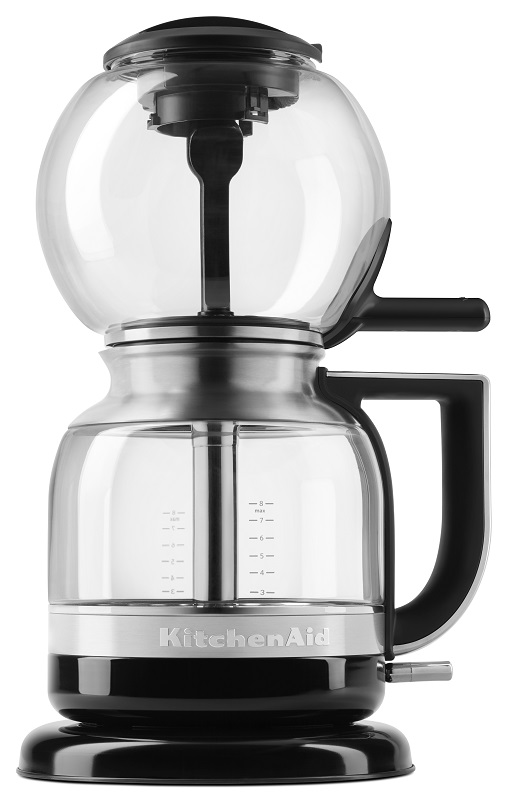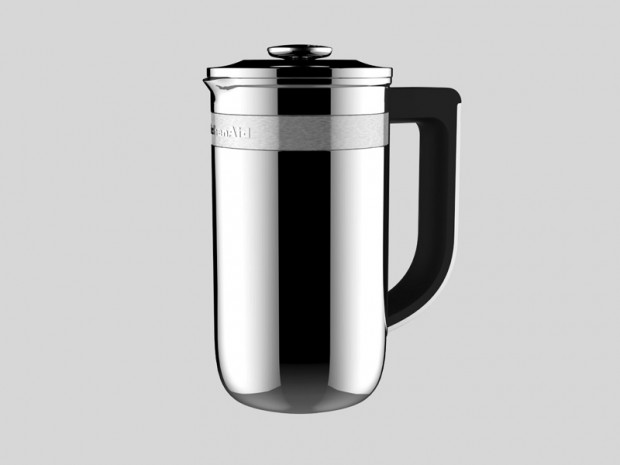Born in 1919 at the behest of the Hobart Corporation for the production of consumer-friendly standing mixers that relieve home cooks from the labor of kneading and stirring, KitchenAid is a company firmly rooted in the culture of mechanized convenience. It’s ironic to note that by today’s standards, use of its flagship product is almost oppositely now associated with an enterprising spirit of DIY baking and cooking — although the company still knows how to spot a trend worth simplifying.
A special, media-rich chapter of its website is dedicated entirely to its pursuit of “craft coffee,” including information about the Pro Line Series Espresso Maker, the Pour Over Coffee Brewer, and a new product just reaching the public this summer: the Siphon Coffee Brewer.
The KitchenAid vac pot differs from the Hario, Yama and other systems used in commercial retail settings in several ways, but most significantly in its integrated electric heat source. Whereas coffee bars generally opt for small, adjustable burners or halogen beam heaters, the KitchenAid’s bottom carafe is heated in a manner similar to an electric water kettle, with a concealed heating element built into the base. Another interesting difference is that the junction of the top and bottom carafes of the KitchenAid siphon is sealed magnetically, as opposed to with gaskets that cling into a seal when heated. Marketing materials assert that the magnetic connection is easier to separate for serving and cleaning immediately after use.
Other differences include a washable, reusable plastic-framed stainless steel mesh filter, a plastic handle for easier removal of the upper chamber and a dedicated stand for placing the upper chamber once it is removed. The KitchenAid also features a stainless steel descending tube, which is less prone to breakage than a conventional glass tube.
In a video posted online by KitchenAid, designers are seen handling Bodum and Hario manual siphon brewing equipment. Notably absent from the table in the video is the Sunbeam Coffeemaster, an electric siphon coffee system from the 1940s that featured a built-in heat source, metal tube and upper chamber handle.
Operation of the KitchenAid siphon brewer offers push-button convenience at the expense of the manual controls that professional and home baristas use to achieve the nuanced results for which the method is heralded. Traditional vac pots, both stovetop and freestanding, benefit from adjustable heat sources so that the coffee is not unduly boiled, utilizing only as much heat as is necessary to force the majority of the water upward to steep. Aside from a gentle stir applied manually by the barista, the mixture in the upper chamber of a standard vac pot is minimally agitated and is never boiled.
With the push of a single button, the KitchenAid brings the water in the bottom chamber to a rolling boil and apparently continues to heat the bottom chamber until all the water has been forced up the tube by the accumulated vapor pressure. The brewing mixture in the upper chamber tumbles visibly from the continuing force of boiling water and rising vapor. Utilizing what appears similar to the dry-boil protection feature built into standard electric kettles, when the bottom chamber is empty, the heat shuts off automatically. The suddenly cooling vapor causes a contraction that sucks the brew rapidly down through the central filter and back to the bottom chamber in a foamy, spectacular, instantaneous whoosh. Conventional vac pots take an average of 30 seconds to a minute to complete what is typically a slow and delicate “draw down” process.
The fundamental format of siphon or vacuum coffee brewing traces back almost two centuries, with the earliest patents for siphon brewers appearing in the early 1800s. This makes the method about a century older than the ostensibly simpler French press, which, as it happens, KitchenAid also has plans to further simplify. After the Siphon Coffee Brewer, which debuted in July 2015 exclusively through Williams Sonoma, the next product to be introduced into the appliance maker’s “craft coffee” catalog will be the Precision Press Coffee Maker, a 30-ounce, dual-wall insulated stainless steel press pot with a built-in scale and digital timer.
Users can dose their coffee into the Precision Press by weight instead of volume, and then keep an eye on the battery-powered digital timer display built into the handle to keep track of the brewing process. The Precision Press Coffee Maker is slated for release next month with an MSRP of $149.99. The Siphon Coffee Brewer carries an MSRP of $249.99.
Howard Bryman
Howard Bryman is the associate editor of Daily Coffee News by Roast Magazine. He is based in Portland, Oregon.
Comment
3 Comments
Comments are closed.









The irony of its pursuit of “craft coffee” (more like Kraft coffee) where all of its products do everything possible to automate and remove the human hand…
There’s a difference between pursuing craft coffee and trying to eradicate it.
I want to buy the coffee filter machin!
send the options!
Black & Decker and Bodum both made electric vacuum brewers about ten years ago. I had the Black & Decker Infuze model and it was alright. Better than my drip brewer at the time, but you could not change any of the brew settings making it really hit or miss.